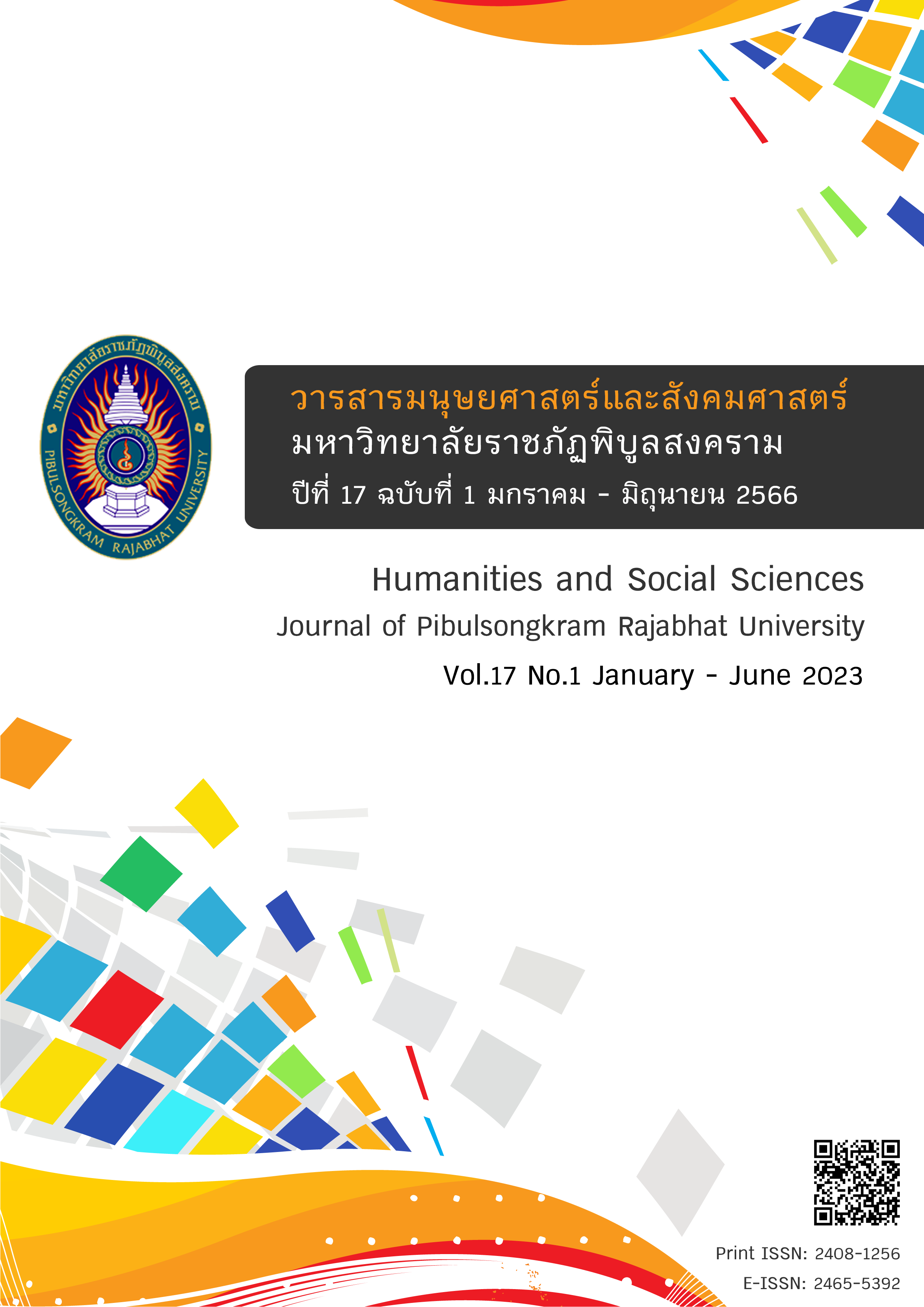Model of Teachers Developing by using the Process of Professional Learning Community in Secondary Schools Supervisory District 18
DOI:
https://doi.org/10.14456/psruhss.2023.5Keywords:
Model of developing teachers, Professional learning community, Secondary schoolAbstract
The purpose of this research study were to 1) study the needs , problem, obstacles and guidelines for developing teachers by using the process of Professional Learning Community in Secondary Schools Supervisory District 18 2) Developing a model for developing teachers by using the process of Professional Learning Community 3) Assess a model for developing teachers by using the process of Professional Learning Community has 3 steps as follows: 1) Study the needs, problem and guidelines for developing teachers by using the process of Professional Learning Community. By studying papers and research to create a conceptual framework for developing teachers by using the process of Professional Learning Community. Asked about the needs and problems of the administrators and teachers of secondary schools in Secondary Schools Supervisory District 18. The number of 450 people from 120 schools and interviewed about the guidelines by using the process of Professional Learning Community from administrators and teachers of Educational institutions that have received royal awards of 3 schools. The data were analyzed by content analysis, frequency, percentage, mean and standard deviation. 2) Developing a model for developing teachers by using the process of Professional Learning Community by the researcher used the data from Step 1 to draft model of developing teachers by using the process of Professional Learning Community in Secondary Schools Supervisory District 18 and check the correctness and appropriateness of the form. with a seminar based on experts and apply recommendations to improve the developed model to be correct and appropriate according to the consensus of experts 3) Assess a model for developing teachers by using the process of Professional Learning Community with the Verification Model by using 48 stakeholders provided their opinions and assessed the usefulness and feasibility of the model. including making policy recommendations and practical recommendations. The results of the study found that model of developing teachers by using the process of Professional Learning Community in Secondary Schools Supervisory District 18 together with 1) Model name 2) Objectives 3) Principles 4) Community process of professional learning is creating a common vision, building shared leadership, exchanging knowledge, beliefs and values, learning and professional development and 5) supporting conditions. which the model developed are accurate, appropriate, useful and feasible, and pass all assessment criteria.
References
กัสมัสห์ อาแด. (2561). การพัฒนารูปแบบชุมชนการเรียนรู้ทางวิชาชีพด้วยกระบวนการวิจัยปฏิบัติการแบบร่วมมือร่วมพลัง ในโรงเรียนประถมศึกษา (วิทยานิพนธ์ปรัชญาดุษฎีบัณฑิต). ชลบุรี: มหาวิทยาลัยบูรพา.
คณะกรรมาธิการการศึกษาวุฒิสภา. (2552). แนวทางการปฏิรูปการศึกษาในทศวรรษที่สอง. กรุงเทพฯ: เลขาธิการวุฒิสภา.
นันท์นภัส ชัยสงคราม. (2561). การเสริมสร้างชุมชนการเรียนรู้วิชาชีพทางการศึกษาในสถานศึกษาขั้นพื้นฐาน สังกัดสำนักงานเขตพื้นที่การศึกษาประถมศึกษาสุพรรณบุรี เขต 1 (วิทยานิพนธ์ศิลปศาสตรมหาบัณฑิต) กรุงเทพฯ: มหาวิทยาลัยธุรกิจบัณฑิตย์.
บุญยฤทธิ์ ปิยะศรี. (2556). รูปแบบการพัฒนาวิชาชีพครูเพื่อเสริมสร้างสมรรถนะการสอนที่เน้นความแตกต่างระหว่างบุคคล (วิทยานิพนธ์ปรัชญาดุษฎีบัณฑิต) กรุงเทพฯ: มหาวิทยาลัยศิลปากร.
พิสิษฐ์ แก้ววรรณะ. (2557). การพัฒนาครูด้านการจัดการเรียนรู้ ตามแนวทฤษฎีการเรียนรู้เพื่อสร้างสรรค์ด้วยปัญญา (วิทยานิพนธ์ครุศสาตรมหาบัณฑิต). เชียงใหม่: มหาวิทยาลัยราชภัฏเชียงใหม่.
มินตรา ลายสนิทเสรีกุล, และปิยพงษ์ สุเมตติกุล. (2557). กลยุทธ์การบริหารโรงเรียนสู่การเป็นชุมชนแห่งการเรียนรู้วิชาชีพของโรงเรียนมัธยมศึกษาในสหวิทยาเขตเบญจบูรพา กรุงเทพมหานคร. วารสารอิเล็กทรอนิกส์ทางการศึกษา, 9(3), 392 - 406.
ยุทธชัย จริตน้อม. (2564). การพัฒนารูปแบบการบริหารเพื่อการเป็นชุมชนการเรียนรู้ทางวิชาชีพของโรงเรียนประถมศึกษา สังกัดสำนักงานศึกษาธิการภาค 11 (วิทยานิพนธ์ปรัชญาดุษฎีบัณฑิต). สกลนคร: มหาวิทยาลัยราชภัฏสกลนคร.
เรวณี ชัยเชาวรัตน์. (2558). กระบวนการเสริมสร้างความสามารถในการออกแบบการเรียนการสอนของนักศึกษาปฏิบัติการวิชาชีพครูตามแนวคิดชุมชนแห่งการเรียนรู้ทางวิชาชีพ : การวิจัยกรณีศึกษา (วิทยานิพนธ์ครุศาสตร์ดุษฎีบัณฑิต). กรุงเทพฯ: จุฬาลงกรณ์มหาวิทยาลัย.
วรรณภร ศิริพละ. (2559). รูปแบบการพัฒนาครูของมหาวิทยาลัยราชภัฏ. กรุงเทพฯ : มหาวิทยาลัยสยาม.
วาสนา ทองทวียิ่งยศ. (2560). ปัจจัยที่ส่งผลต่อการเป็นชุมชนแห่งการเรียนรู้ทางวิชาชีพของครูในสถานศึกษาระดับมัธยมศึกษา (วิทยานิพนธ์ศึกษาศาสตรมหาบัณฑิต). ปทุมธานี: มหาวิทยาลัยเทคโนโลยีราชมงคลธัญบุรี.
ศรสวรรค์ เพชร์มี. (2558). ปัจจัยที่ส่งผลต่อความเป็นชุมชนแห่งการเรียนรู้ทางวิชาชีพของโรงเรียนสังกัดสำนักงานเขตพื้นที่การศึกษามัธยมศึกษา เขต 38 จังหวัดตาก (วิทยานิพนธ์การศึกษามหาบัณฑิต). พิษณุโลก: มหาวิทยาลัยนเรศวร.
สมาพร มณีอ่อน. (2560). กลยุทธ์การนำกระบวนชุมชนการเรียนรู้ทางวิชาชีพ (PLC) ไปใช้ในโรงเรียน. วารสารศึกษาศาสตร์ มหาวิทยาลัยศิลปากร, 15(1), 30-31.
สหรัฐ เต็มวงษ์, สุชาติบางวิเศษ, และกิติศักดิ์ เสนานุช. (2559). ปัจจัยที่ส่งผลต่อการเป็นชุมชนแห่งการเรียนรู้ของโรงเรียน สังกัดสำนักงานเขตพื้นที่การศึกษามัธยมศึกษา เขต 19. ใน The National and International Graduate Research Conference, HMP(21) (น. 1244–1254). ขอนแก่น: มหาวิทยาลัยขอนแก่น.
สำนักงานเลขาธิการสภาการศึกษา. (2552). ข้อเสนอการปฏิรูปการศึกษาในทศวรรษที่สอง (พ.ศ. 2552 - 2561). กรุงเทพฯ: พริกหวานกราฟฟิค.
สำนักงานสภาพัฒนาการเศรษฐกิจและสังคมแห่งชาติ. (2565). แผนพัฒนาเศรษฐกิจและสังคมแห่งชาติ ฉบับที่สิบสาม พ.ศ. 2566-2570. กรุงเทพฯ: สำนักนายกรัฐมนตรี.
อนุสรา สุวรรณวงศ์. (2559). คุณลักษณะของชุมชนแห่งการเรียนรู้ทางวิชาชีพในบริบทการศึกษาไทย. วารสารปัญญาภิวัฒน์, 8(1), 163 – 175.
DuFour, R., & Eaker, R. (2006). Learning by Doing A Handbook for Professional Learning Communities at work : Bloomington, IN : Solution. Education Service.
Krejcie, R. V., & Morgan, D. W. (1970). Determining sample size for research activities. Educational and psychological measurement, 30(3), 607-610.
Senge, Perter M. (1990). The fifth discipline: the art and practice of the learning organization (Revised ed.). New York : Currency/Doubleday.
Ullman, E. (2009). How to create a professional learning community. Retrieved January, 3, 2017. Accessed December 23, 2021 . Available from https://www.edutopia.org/professional-learning-communities-collaboration-how-to
Verbiest, E., Ansems, A., Bakx, A., Grootswagers, I., Heijmen-Versteegen, T., Jongen, T., ... & Teurlings, C. (2005). Collective learning in schools described: Building collective learning capacity. REICE - Revista Electrónica Iberoamericana sobre Calidad, Eficacia y Cambio en Educación, 3(1), 17 - 38.
Downloads
Published
How to Cite
Issue
Section
License
Copyright (c) 2022 Humanities and Social Sciences Journal of Pibulsongkram Rajabhat University

This work is licensed under a Creative Commons Attribution-NonCommercial-NoDerivatives 4.0 International License.
Any articles or comments appearing in the Journal of Humanities and Social Sciences, Rajabhat Phibulsongkram University, are the intellectual property of the authors, and do not necessarily reflect the views of the editorial board. Published articles are copyrighted by the Journal of Humanities and Social Sciences, Rajabhat Phibulsongkram University.









